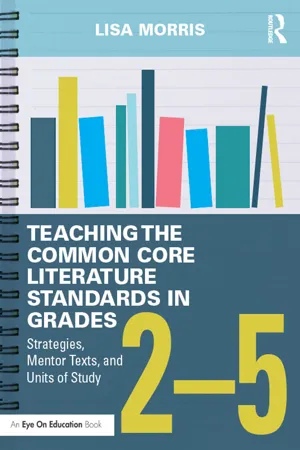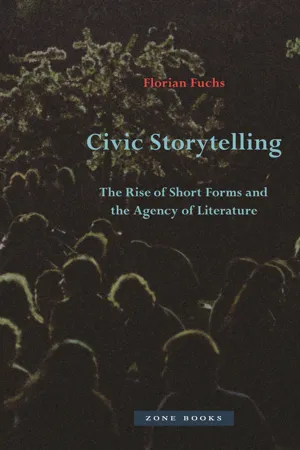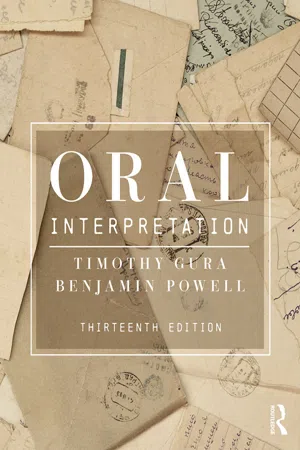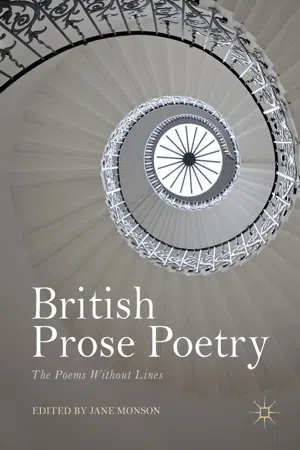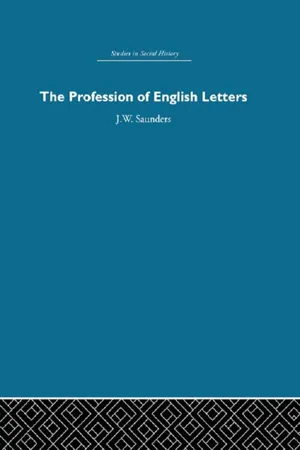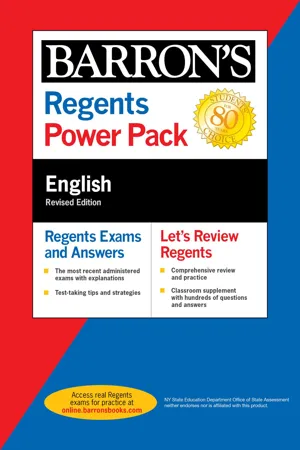Literature
Prose
Prose refers to written or spoken language that follows natural speech patterns and does not adhere to a specific metrical structure, as opposed to poetry. It is the most common form of written language and encompasses a wide range of literary works, including novels, short stories, essays, and non-fiction. Prose allows for more flexibility in expression and storytelling compared to poetry.
Written by Perlego with AI-assistance
Related key terms
1 of 4
Related key terms
1 of 3
7 Key excerpts on "Prose"
- eBook - ePub
Teaching the Common Core Literature Standards in Grades 2-5
Strategies, Mentor Texts, and Units of Study
- Lisa Morris(Author)
- 2015(Publication Date)
- Routledge(Publisher)
Normal everyday speech is spoken in Prose and most people think in Prose. It is basically the standard style of writing that students come into contact with each day (literature, speeches, broadcasts, etc.) One of my favorite quotes by Mother Teresa is an example of Prose: “The poor are very great people. They can teach us so many things.” The language is simple, direct, and leaves the reader with a message. That is not to say that Prose writing does not have the elements of craft language that were covered in Chapter 5. On the contrary, it does; the rhyming and rhythmic nature may not be found but creativity certainly is. Effective Teaching Strategies for Prose 1. Read 2. Write 3. Discuss 4. Integrate technology There are several types of Prose: 1. Nonfiction Prose —biographies and essays 2. Fictional Prose —chapter books, novels, stories 3. Heroic Prose —legends and tall tales 4. Prose poetry —poetry, usually written in the narrative, but not written in verse, unlike much of the poetry students read. Teaching Prose means teaching reading with comprehension. Teachers often ask students to name the basic story elements of what they have read: setting, character, problem, and solution. As readers mature in their understanding of these basic elements, teachers want students to read with more depth of meaning and understanding. Students gain this deeper understanding by interpreting the author’s purpose, inferring themes and internal messages and making personal connections. The key is to use a variety of strategies to keep students motivated and interested. The simplest way for me to do that is to make sure I select mentor texts that appeal to my students and that I have studied. Teaching Students to Interpret Prose Orally According to Jim Trelese, “The most common mistake in reading aloud is reading too fast.” Encourage students to read slowly enough for the reader to build mental pictures, also making sure that the text level is appropriate for the reader - eBook - ePub
Civic Storytelling
The Rise of Short Forms and the Agency of Literature
- Florian Fuchs(Author)
- 2023(Publication Date)
- Zone Books(Publisher)
In the language of literary studies, one could say that short forms partook of the deep phenomenological change that occurred between the fourteenth and seventeenth centuries in how textual fiction behaved between the reader and the world. During this era, what is called classical and medieval “poetry” — drama, lyric, and epic works written in verse and abiding by the poetic rulebooks from Aristotle’s Poetics to Scaliger’s Poetices libri septem — was increasingly challenged by a new mode of speech that we still call “literature” — fictional Prose narratives without meter or verse and written in various lengths and genres. This new regime of literature in modernity has thus been described — quite accurately — as the arrival of Prose. 1 Its implications, vast in scope, were nothing less than the replacement of the spoken word by printed text and of the reciting of poetry by the silent reading of Prose. In doing so, Prose literature fundamentally disrupted and reconfigured the relationship between reader and world, initiating a new phenomenality of the behavior and appearance of Prose genres in the world. The phenomenality was broad and broadly felt, affecting everything from the material apparatuses of reading and the technologies governing the circulation of readable forms to its imaginary, discursive, and social effects - eBook - ePub
- Timothy Gura, Benjamin Powell(Authors)
- 2018(Publication Date)
- Routledge(Publisher)
Part I , we discussed how to analyze stories and poems and, then, how to apply that analysis to build performances which embody and evoke the complexities we discovered. The techniques we explored could be used with all types of writing. So, equipped with those critical tools, we looked at how the voice and body could be trained to respond to the major challenges performing presents. That study constructed the foundation on which we now can develop a much more sophisticated exploration.Literature shares many common aspects, of course, but different modes boast distinctive characteristics. For example, you encounter different personas in stories, in plays, and in poems—but drama capitalizes on the interaction of characters. Likewise, you can find narrators or storytellers in poems and plays, but they are the essential figures in Prose fiction. We explore these unique challenges arising from various kinds of literature in the next three parts: Part II concerns Prose, Part III examines drama, and Part IV delves into poetry.We are interested in communicating literature to listeners. An interpreter soon discovers the problems and advantages in each type of literature and then goes beyond this generalization to the specific, individual variations within a particular selection. Regardless of its form or type, each selection should be approached as an individual example. Before we consider the various kinds of Prose, we review some aspects of literary style found in all Prose writing. We focus here on nondramatic Prose.Nondramatic Prose can take many forms: an encyclopedia, a user’s manual for your DVD player, a personal essay, a blog entry, a tweet, a letter, a Facebook post, an oral history, this textbook. Such diverse examples share some important characteristics, and for the interpreter none is more instructive for performance than “style.” After reviewing the general topic of style, we focus on increasingly narrow components in more and more detail. Starting with the role of paragraphs, we drill down to sentences (those things that paragraphs are made of), zero in on speech phrases (what sentences themselves are made of), and conclude with words themselves: why they are chosen (diction), how they sound (tone color), how they live with neighboring words (rhythm - Josephine Guy, Ian Small(Authors)
- 2012(Publication Date)
- Routledge(Publisher)
4 Non-Fictional Prose
The author of a popular encyclopaedia entry on non-fictional Prose, while conceding that to define it ‘is an immensely challenging task’, nevertheless confidently goes on to characterize the genre as ‘any literary work that is based mainly on fact’, such as ‘the essay and biography’. Excluded from this category are any ‘highly scientific and erudite writings in which no aesthetic concern is evinced’.1 Leaving aside for the moment the conflation of the ‘literary’ with the ‘aesthetic’, we can note how this definition recalls the practice of an earlier generation of literary historians, such as F. W. Bateson, whose account of Matthew Arnold’s Culture and Anarchy in his 1940 Cambridge Bibliography of English Literature treated non-fictional Prose as being more or less synonymous with a tradition of critical writing, the value of which resided as much in what Stefan Collini has described as the distinctive ‘voice’ of the critic as in the originality or cogency of the ideas expressed (Collini 1988: 1). More recently Collini has invoked the power of voice to explain the remarkably longevity of Newman’s The Idea of a University , a volume which, he claims, continues to command the attention of modern readers despite the fact that many aspects of its argument are irrelevant, dated, or transparently erroneous (Collini 2010). In the mid-nineteenth century that voice—traditionally to be found in the work of Victorian ‘sages’ such as Carlyle, Arnold, Mill, and Ruskin—might range widely, moving effortlessly among topics such as religion, history, science, philosophy, and politics, as well as literature and the arts, at least until the 1880s when far-reaching changes in the social organization of knowledge increasingly came to equate authority and expertise with specialization and professionalization. As Philip Davis puts matters in his contribution to the new Oxford English Literary History- eBook - ePub
British Prose Poetry
The Poems Without Lines
- Jane Monson, Jane Monson(Authors)
- 2018(Publication Date)
- Palgrave Macmillan(Publisher)
6 So, ‘poetry’ in Prose implies writing in Prose form that incorporates the qualities of poetry: ‘direct language’ with ‘arrest[ing]’ images (Hulme); a dynamic, energized and relational take on the ‘world’ (Binyon).Of course, these were not the only re-definitions. Another way to understand differences among definitions is to separate the camps redefining ‘poetry’ according to the other art form that would serve as model: music (emphasis on rhythm, metricality, recalling Pater’s ‘All art constantly aspires towards the condition of music’ from The School of Giorgione ) or painting (emphasis on image and picture). Undoubtedly, such a division risks oversimplification. After all, even Ezra Pound ’s ‘A Few Don’ts by an Imagiste’ in Poetry (March 1913) addresses both image and rhythm, or, as F.S. Flint summarizes in the essay that precedes Pound’s in the volume: ‘Direct treatment of the “thing,” whether subjective or objective’, and ‘As regarding rhythm: to compose in sequence of the musical phrase, not in sequence of a metronome.’7 But, for some practitioners and critics, the musicality of poetic Prose was definitional as opposed to an unmediated presentation of modern life. The American poet Amy Lowell ’s ‘polyphonic Prose’ is a case in point. In ‘Miss Lowell’s Discovery: Polyphonic Prose’, John Gould Fletcher praises the ‘orchestral quality’ of her work, concluding that ‘it seems fitting that a new name should be given to these poems of hers, which, printed as Prose, or as Prose and verse interspersed, display all the colors of the chromatic palette.’8 Other critics were less convinced; Harriet Monroe, in reviewing the second Imagist collection, Some Imagist Poets —An Anthology , remarks that ‘Miss Lowell’s “polyphonic Prose” in The Bombardment remains for me scientific and artificial, an interesting experiment rather than a new poetic form.’9 Lowell herself attempts distinctions, noting that ‘it is the fashion today to call everything which is without metre vers libre .’ She answers any confusion of verse and Prose (of which Fletcher’s remark is an instance) with such a metrical approach, mapping a spectrum of rhythmic distinctions with ‘pure Prose and pure poetry’ as the extremes, and ‘metrical Prose’ and ‘vers libre’ as ‘steps’ in between.10 In the end, her divisions are at best tendencies: ‘Now as Prose is a long curve with very little return, and poetry is a much shorter curve with a very sharp return; so metrical Prose may be considered as a slightly more curved line than is usual in Prose, with a return beginning to be felt, and vers libre as curving still more markedly, and the return becoming pronounced.’11 T.S. Eliot, in ‘The Borderline of Prose’, takes a similar tack in criticizing Richard Aldington ’s Prose poems as failures in that they incorporate both Prose and verse rhythms. Eliot quotes a passage from a Prose poem by Aldington, then critiques the opening phrases: ‘For my sake Eos, in a cloudless sky, gliding from the many-isled sea, must be more tender and more thrilling.’ Eliot objects to the difference between the verse rhythms of ‘For my sake Eos, in a cloudless sky, gliding from the many-isled sea’ and the Prose of ‘must be more tender and more thrilling.’ Eliot’s distinctions are even less defined than Lowell’s; he simply labels what are Prose rhythms and what are verse to his ear.12 - eBook - ePub
- J.W. Saunders(Author)
- 2013(Publication Date)
- Routledge(Publisher)
1 The poets led by Dryden and Pope were as important as they had ever been: their work was discussed and criticized in the coffee-houses as enthusiastically as Elizabethans ever argued about poetry in their courtly salons; and for the first time poetry was accepted in the neo-classical eighteenth century as the literary art best suited for national statements of dignity and decorum—epic, translation, satire, commemorative ode, and didactic commentary. All the same, writers now invented and developed other media of imaginative expression: the essay, the sermon, the speech, the letter, each transformed into important means of art in this age.Christopher Caudwell suggests that poetry, the mnemonic art, is essentially the ‘language of collective speech and public emotion’, while Prose is essentially the language of business, conversation, private letters and teaching; that is to say, the private language of one man with another. From this point of view, the more ‘private’ literature became, the more important, as an art, Prose became. Further, the ‘Augustans’ of the eighteenth century, the squires and merchants who came to dominate society, were men of business, conversation, letters and teaching. Just as the prevailing mood of the Enlightenment in the new age emphasized in language the qualities of plainness, succinctness, clarity and explicitness, and in life and living the scientific, mathematical, common-sense approach, so in literature it stressed the useful and the didactic. The Augustans demanded a particular balance, between fancy and fact, between imagination and judgment, between dignity and common sense, between fiction and truth. This demand produced a new set of values for poetry; it also induced a new flood of Prose. Hence, the biographies and biographical collections, essays learned and occasional, sermons, critical editions and criticism, articles, handbooks, anthologies, encyclopaedias, even dictionaries, and in the end, when Puritan suspicions about the value of fictitious literature had been relieved by ingenious formulae combining fiction and truth, the novels. And thus, for the first time, to put beside the roll of the poets, a roll of Prose authors, numbering among them the first genuine professionals of letters: Johnson, Defoe, Richardson, Fielding, Smollett, Sterne, Goldsmith, as well as Gibbon, Burke, Bunyan, Pepys, Locke, Swift, Addison, Steele, Berkeley, Adam Smith, Hume, Chesterfield, Junius, Boswell. - eBook - ePub
- Carol Chaitkin(Author)
- 2021(Publication Date)
- Barrons Educational Services(Publisher)
The New York Times.- prologue An introductory statement of the dramatic situation of a play or story. Shakespeare’s Romeo and Juliet begins with a brief prologue. The first two pages of Fitzgerald’s The Great Gatsby are a prologue to the story Nick Carraway will tell.
- Prose Most of what we write is Prose, the expression in sentences and phrases that reflect the natural rhythms of speech. Prose is organized by paragraphs and is characterized by variety in sentence length and rhythm.
- protagonist A term from Ancient Greek drama, it refers to the central character, the hero or heroine, in a literary work.
- realism The literary period in the United States following the Civil War is usually called the Age of Realism. Realism depicts the directly observable in everyday life. Realistic writers seek to present characters and situations as they would appear to a careful observer, not as they are imagined or created by the author. After 1865, American writers became increasingly interested in the sources of power and force, and in the means to survival and success, in an increasingly materialistic society. For writers of this period, realism was a literary mode to express a naturalistic philosophy. See also naturalism, verisimilitude.
- rhetoric From Ancient Greece, the art of persuasion in speech or writing achieved through logical thought and skillful use of language.
- rhetorical question A question posed in the course of an argument to provoke thought or to introduce a line of reasoning.
- romance A novel or tale that includes elements of the supernatural, heroic adventure, or romantic passion. Hawthorne’s The Scarlet Letter is a romance, not because it is a love story but because it goes beyond verisimilitude
Index pages curate the most relevant extracts from our library of academic textbooks. They’ve been created using an in-house natural language model (NLM), each adding context and meaning to key research topics.
Explore more topic indexes
Explore more topic indexes
1 of 6
Explore more topic indexes
1 of 4
